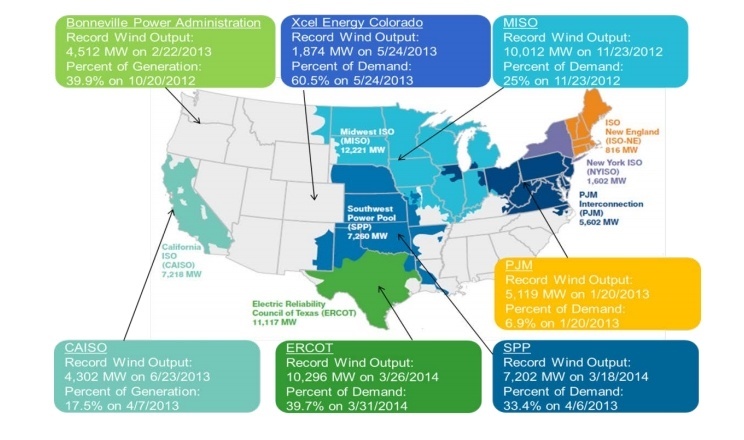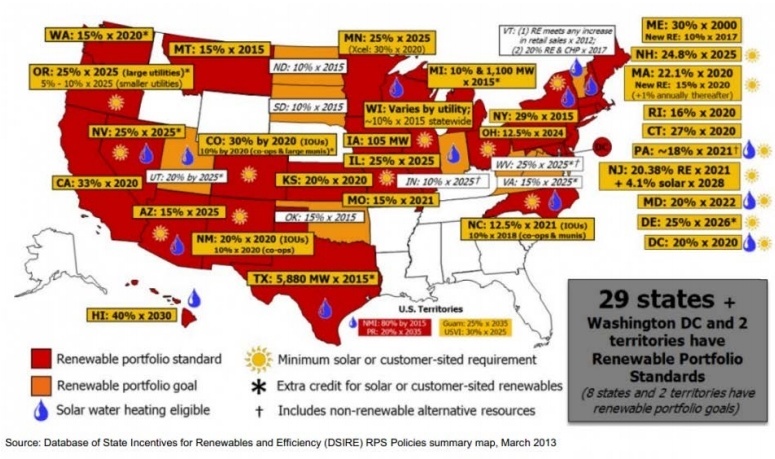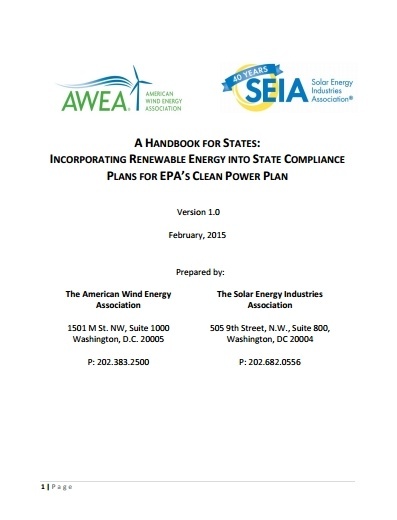News Release from American Clean Power Association (ACP)
Wind Industry Profile of
What's New in the Windfair World - Assistance provided to US States in complying with EPA’s Clean Power Plan
The American Wind Energy Association (AWEA) and Solar Energy Industries Association (SEIA) have jointly published a handbook for states detailing how to incorporate renewable energy into state plans to comply with the U.S. Environmental Protection Agency’s Clean Power Plan, the proposed regulation to cut carbon emissions from existing power plants.
“Wind energy already cuts power sector carbon emissions by more than five percent a year, while growing U.S. manufacturing and generating tens of billions of dollars of investment, including in economically distressed rural areas,” said AWEA CEO Tom Kiernan. “This new handbook provides a helping hand to states, allowing them to capitalize on the economic and environmental benefits of renewable energy while diversifying their energy mix and lowering costs for consumers.”
“Last year, solar energy helped to offset more than 22 million metric tons of harmful carbon emissions in the U.S., which is the equivalent of removing 4.7 million cars off our roads and highways or saving 2.5 billion gallons of gasoline,” said SEIA president and CEO Rhone Resch. “For states looking to meet new obligations under the Clean Power Plan, solar and wind energy can be real game changers.”
“A Handbook for the States: Incorporating Renewable Energy into State Compliance Plans for EPA’s Clean Power Plan” released by AWEA and SEIA interprets the more than 1,000 pages of the draft EPA rule and technical support documents and provides step-by-step guidance to states on how to incorporate renewable energy into their state compliance plans.
The handbook details the benefits of using renewable energy as a compliance tool, including the consumer benefits created by integrating low-cost renewables and provides access to dozens of in-depth renewable integration studies confirming significant amounts of wind and solar energy can be added to the power system without harming reliability.

Wind energy integration records set in the U.S. 2012-2014 / Source: AWEA Annual Market Report for the Year Ending 2013
As noted in the handbook, wind energy’s costs have fallen by more than half in just five years and wind is considered by far the lowest cost generation option for reducing electric sector carbon emissions. Installed solar system prices, meanwhile, have dropped by 49 percent since 2010.
State officials can also use the handbook to calculate the carbon reductions from wind and solar energy and how to track and credit such reductions. This includes two sample frameworks for model state compliance plans using renewable energy as the key tool to meet the carbon reduction targets.
The handbook also notes obtaining 4.5 percent of U.S. electricity from wind has already cut electric sector carbon emissions by over 5 percent and reduced U.S. emissions by 126 million short tons of carbon dioxide in 2013 - equal to 20 million cars’ worth of emissions. Cutting carbon emissions from wind energy will rapidly increase and create added benefits for consumers and the U.S. economy as it scales-up according to the U.S. Department of Energy’s recently released Wind Vision.

Renewable Portfolio Standards
By the end of 2016, the amount of installed solar capacity in the U.S. is expected to double, growing from 20 GW to 40 GW – benefitting both the economy and environment – with the expected reductions in carbon emissions the equivalent of shuttering 10 coal-fired plants.
American wind power added significantly more new electricity than any other resource in2014, with cumulative installed capacity increasing eight percent to a total of 65,879 MW. Once recently added U.S. wind projects have had a full year of production, total wind output will rise to powering the equivalent of 18 million homes.
AWEA and SEIA are urging Congress to extend the Production Tax Credit (PTC) and Investment Tax Credit (ITC) to ensure that wind and solar will be ready – and at scale – to keep our nation’s air clean, reduce consumer costs, drive business development and create thousands of new American jobs once there is a policy that appropriately values carbon-free electricity.
This new handbook will be updated after EPA releases its final rule, expected during the summer of 2015.
To receive more information on this article, our Newsletter or find out more about what w3.windfair.net has to offer, please, do not hesitate to contact Trevor Sievert at ts@windfair.net.
Please don't forget to follow us on Twitter: w3.windfair.net on Twitter
w3.windfair.net is the largest international B2B internet platform in wind energy – ultimately designed for connecting wind energy enthusiasts and companies across the globe.
- Source:
- American Wind Energy Association
- Author:
- Trevor Sievert, Online Editorial Journalist / By AWEA Staff
- Email:
- windmail@awea.org
- Link:
- www.awea.org/...


